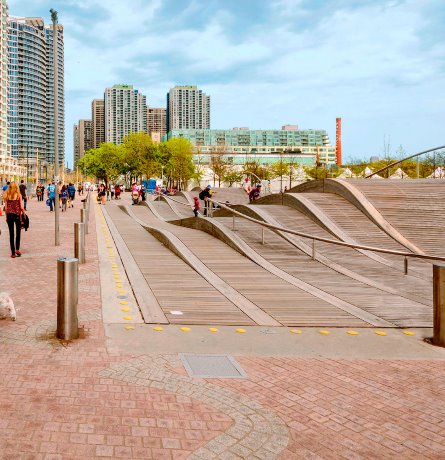TORONTO—A 1.7 kilometre section of Toronto’s main waterfront street has been transformed.
After three years of construction, the city’s revitalized waterfront boulevard opened to the public in June, on schedule and in time for both the Pan Am Games and the Redpath Waterfront Festival.
The $128.9 million Queens Quay revitalization project was funded by the federal, provincial and city governments through Waterfront Toronto, explains a release. The City of Toronto provided $65.2 million, the province $14.5 million, the federal government $13.4 million and Waterfront Toronto $35.7 million.
The money went towards a variety of features, including a wide red granite pedestrian promenade, with benches and trees planted using Silva Cells, which stitch the area together; a separated bike path that provides the missing link of the Martin Goodman Trail and features dedicated bicycle signals; a new dedicated right-of-way for transit users with, new, fully accessible platforms and shelters and a prioritized signal system; dedicated turning lanes and signals, lay-bys for car and bus passenger drop-offs; and new north-side sidewalks and landscaping that extend to the edge of storefronts.
Under the street, infrastructure has been replaced or upgraded, including power, gas, water, sewage and telecommunications systems, a release reads.
The design for the new Queens Quay came to be after an international design competition, years of public consultation as well as an extensive environmental assessment process.
Arup, a multidisciplinary engineering and consulting firm, played a role in the project, working with DTAH and West 8 as a key collaborator from inception through to completion. The firm was tasked with providing transportation planning and civil engineering advice, and subsequently led the environmental assessment that was approved in 2009, the release states.
Arup was also responsible for the design of the road and track alignment, special track work, drainage, civil and municipal services, platforms, structural, and transit priority signal timing, as well as the utilities co-ordination, transportation planning, traffic engineering, transit planning and engineering, and traffic modeling.
Arup also co-ordinated with the Toronto Transit Commission (TTC) to ensure systems integrated into the civil, road, track and structural design; and also co-ordinated the permits and approvals associated with the Ministry of the Environment, the City of Toronto, the TTC, and municipal utilities.

This section of the Queens Quay revitalization project showcases the south side at the Simcoe WaveDeck. The $128.9 million project consisted of years of planning and consultations as well as three years of construction. Approximately 1.7 kilometres of Toronto’s main waterfront street, Queens Quay West, including the north and south side of Queens Quay between Yo-Yo Ma Lane to just east of Bay Street was transformed.
Photo: WATERFRONT TORONTO"


Recent Comments
comments for this post are closed